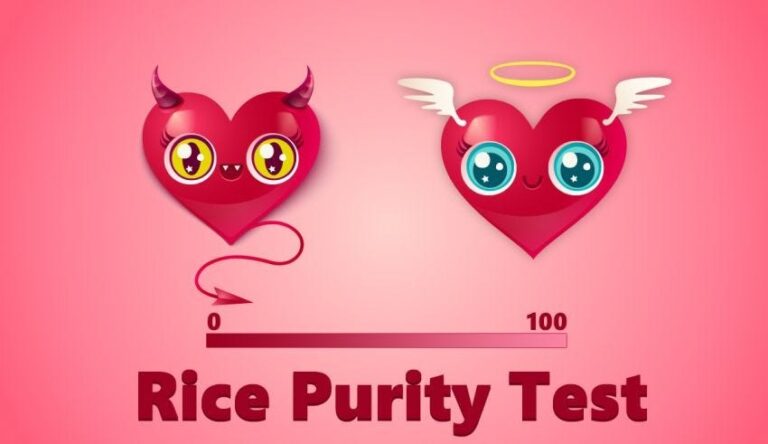Rice Purity Test In the realm of social exploration and self-discovery, the Rice Purity Test has become a notable phenomenon. Originating from Rice University, this test has evolved into a widely embraced way for individuals to reflect on their life experiences and moral compass. Let’s delve into what the Rice Purity Test entails and what makes it a fascinating cultural phenomenon.
What is the Rice Purity Test?
The Rice Purity Test is a self-graded survey that assesses the level of innocence or “purity” of an individual based on their experiences in various aspects of life. It consists of a list of 100 questions, each addressing different behaviors or situations that a person may have encountered. Participants are required to answer honestly based on whether they have ever engaged in or experienced each listed item.
History and Evolution
Originally created by Rice University students as a means of bonding and sharing experiences, the test was later popularized across college campuses and online communities. Its appeal lies in its ability to provoke reflection and discussion about personal values, societal norms, and the diversity of human experiences.
How Does Rice Purity Test Work?
The test is structured with a list of 100 questions, typically divided into categories such as personal habits, relationships, substances, and ethics. Participants mark each question based on whether they have ever engaged in the described activity or situation. Responses are typically marked as “Yes,” “No,” or “Not Applicable,” depending on the rules set by the administering group.
Categories Covered
The questions in the Rice Purity Test cover a wide range of experiences, including:
- Personal Habits: This includes questions about dietary habits, hygiene practices, and personal grooming.
- Sexual Behavior: Questions about sexual activities, preferences, and experiences fall under this category.
- Substances: Queries about alcohol, drugs, and other substances are included to gauge participants’ experiences with them.
- Ethics: This section addresses moral and ethical dilemmas, such as cheating, lying, and breaking the law.
- Risk Behaviors: This covers potentially dangerous activities like gambling, reckless driving, and extreme sports.
Image source: Rice purity test official
Scoring the Rice Purity Test
Scoring the Rice Purity Test is straightforward but can lead to varying interpretations and reflections based on individual experiences and societal norms. Here’s how it works:
How to Score
- Marking Responses: Each question answered with “Yes” counts as one point.
- Total Score Calculation: Add up all the “Yes” responses to get your total score.
- Interpreting the Score: The total score represents your “purity” level, with a higher score indicating more life experiences and a lower score suggesting greater “innocence.”
Score Ranges and Their Meanings
- 0-25:
- Description: Individuals scoring in this range have had extensive life experiences, often involving higher-risk behaviors.
- Interpretation: This may suggest a more adventurous or unconventional lifestyle, with less adherence to traditional norms.
- 26-50:
- Description: A score in this range indicates a significant amount of life experiences, including exposure to various social, sexual, and substance-related activities.
- Interpretation: Individuals in this range have likely explored different aspects of life but may still maintain certain boundaries.
- 51-75:
- Description: This range is often considered moderate, indicating a balanced mix of experiences.
- Interpretation: These individuals have likely engaged in some risk-taking behaviors but have not extensively deviated from societal expectations.
- 76-100:
- Description: Scores in this range reflect higher “purity” or innocence, with fewer life experiences involving risky or unconventional behaviors.
- Interpretation: Individuals scoring here may have a more conservative or cautious approach to life, adhering closely to societal norms and personal values.
Reflection and Discussion
- Self-Reflection: Participants are encouraged to reflect on their scores and consider what they reveal about their life choices, values, and boundaries.
- Peer Comparison: Sharing scores with friends or online communities can foster discussions about personal experiences, societal expectations, and differing perspectives on what constitutes a fulfilling life.
- Changing Scores: It’s important to remember that scores can change over time as individuals grow, explore new experiences, and reassess their values and behaviors.
The Role of Context
While the Rice Purity Test provides a numerical reflection of one’s experiences, it is crucial to consider the context behind each score. Cultural, social, and personal factors all play a significant role in shaping individual behaviors and choices. Therefore, the test should be viewed as a fun and insightful tool rather than a definitive measure of one’s character or life story.
Scoring and Interpretation
After completing the test, participants calculate their score based on the number of “Yes” responses. A lower score typically indicates a higher level of perceived innocence or purity, while a higher score suggests a broader range of experiences. Scores are often shared among peers or discussed in online forums to compare and contrast individual lifestyles and backgrounds.
Cultural Impact
Beyond its original purpose, the Rice Purity Test has become a cultural artifact, influencing discussions about morality, peer pressure, and societal expectations. It serves as a conversation starter and a tool for self-reflection among individuals navigating their personal values and boundaries.
Conclusion
The Rice Purity Test remains a relevant and intriguing aspect of contemporary culture, reflecting the complexities of human behavior and the diversity of personal experiences. Whether taken seriously or in jest, it continues to spark curiosity and introspection, making it a unique phenomenon in the landscape of social interactions and personal growth.
In essence, the Rice Purity Test offers participants a glimpse into their own journey of self-discovery, prompting reflection on the paths taken and the decisions made along the way.
For more exciting news & updates on the Rice Purity Test, Read out our blog today







